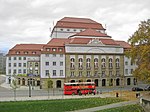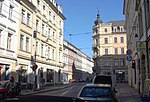St. Francis Xavier Church, Dresden
Buildings and structures demolished in 1957Destroyed churches in GermanyEurope Roman Catholic church stubsFormer churches in DresdenGerman church stubs ... and 2 more
Roman Catholic churches in DresdenSaxony building and structure stubs

The St Francis Xavier Church (katholische Kirche St. Franziskus Xaverius or Katholische Pfarrkirche zu Dresden-Neustadt) was a Roman Catholic church dedicated to St Francis Xavier in the Innere Neustadt district of Dresden. It was built from 1852 to 1853, severely damaged by bombing in 1945 in the Second World War, and demolished in 1957.
Excerpt from the Wikipedia article St. Francis Xavier Church, Dresden (License: CC BY-SA 3.0, Authors, Images).St. Francis Xavier Church, Dresden
Jorge-Gomondai-Platz, Dresden Innere Neustadt (Neustadt)
Geographical coordinates (GPS) Address Nearby Places Show on map
Geographical coordinates (GPS)
| Latitude | Longitude |
|---|---|
| N 51.061666666667 ° | E 13.745555555556 ° |
Address
Gedenkstein Jorge Gomondai
Jorge-Gomondai-Platz
01097 Dresden, Innere Neustadt (Neustadt)
Saxony, Germany
Open on Google Maps











